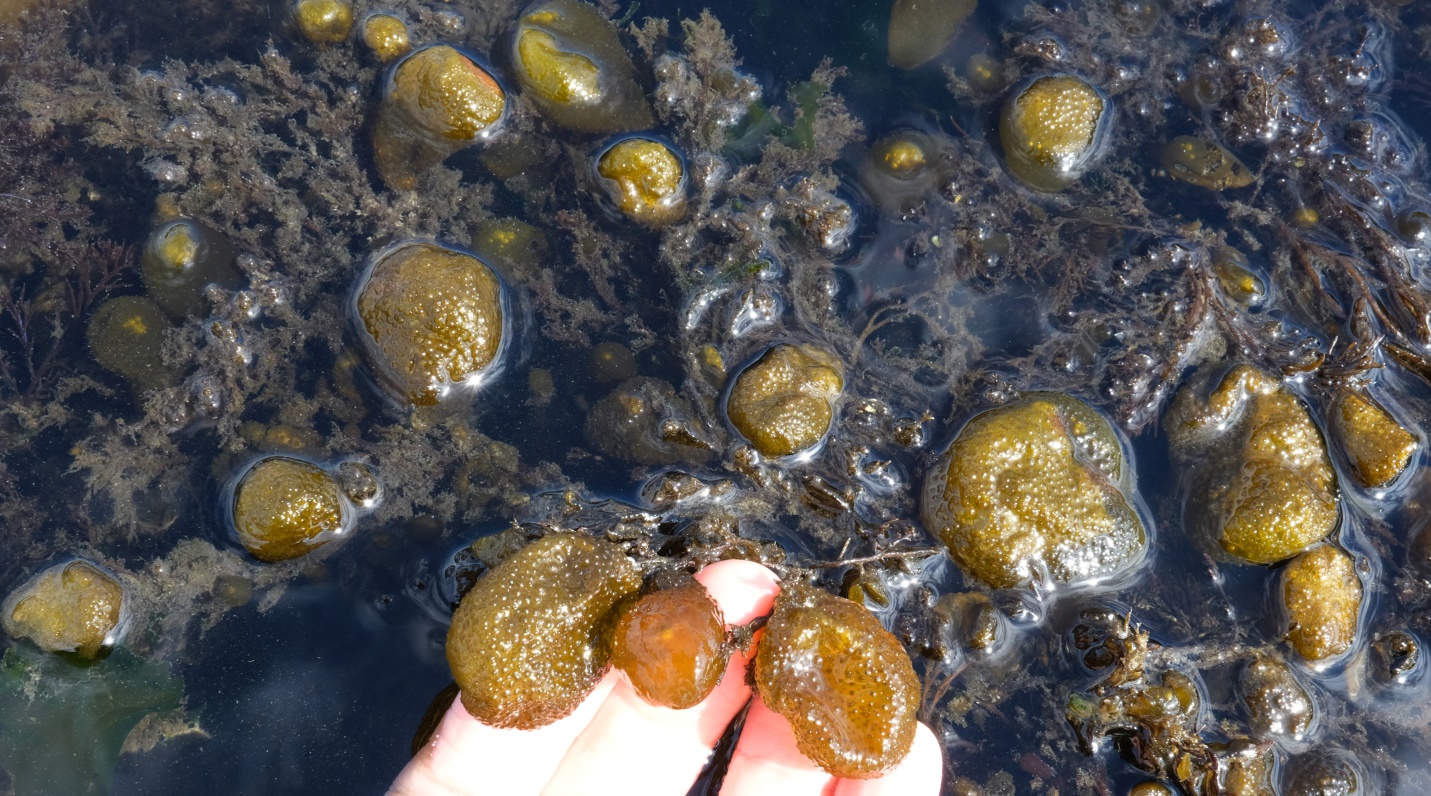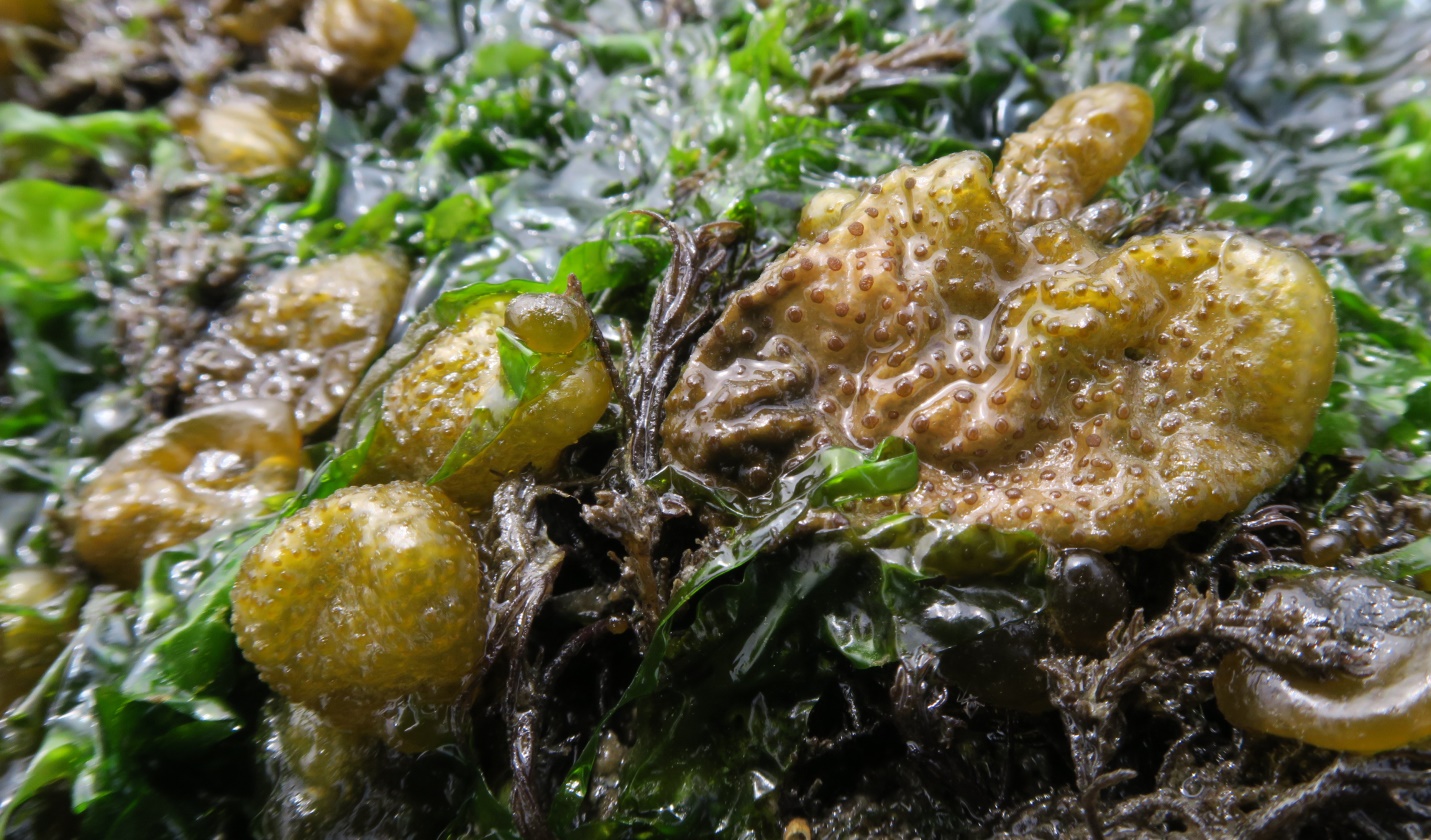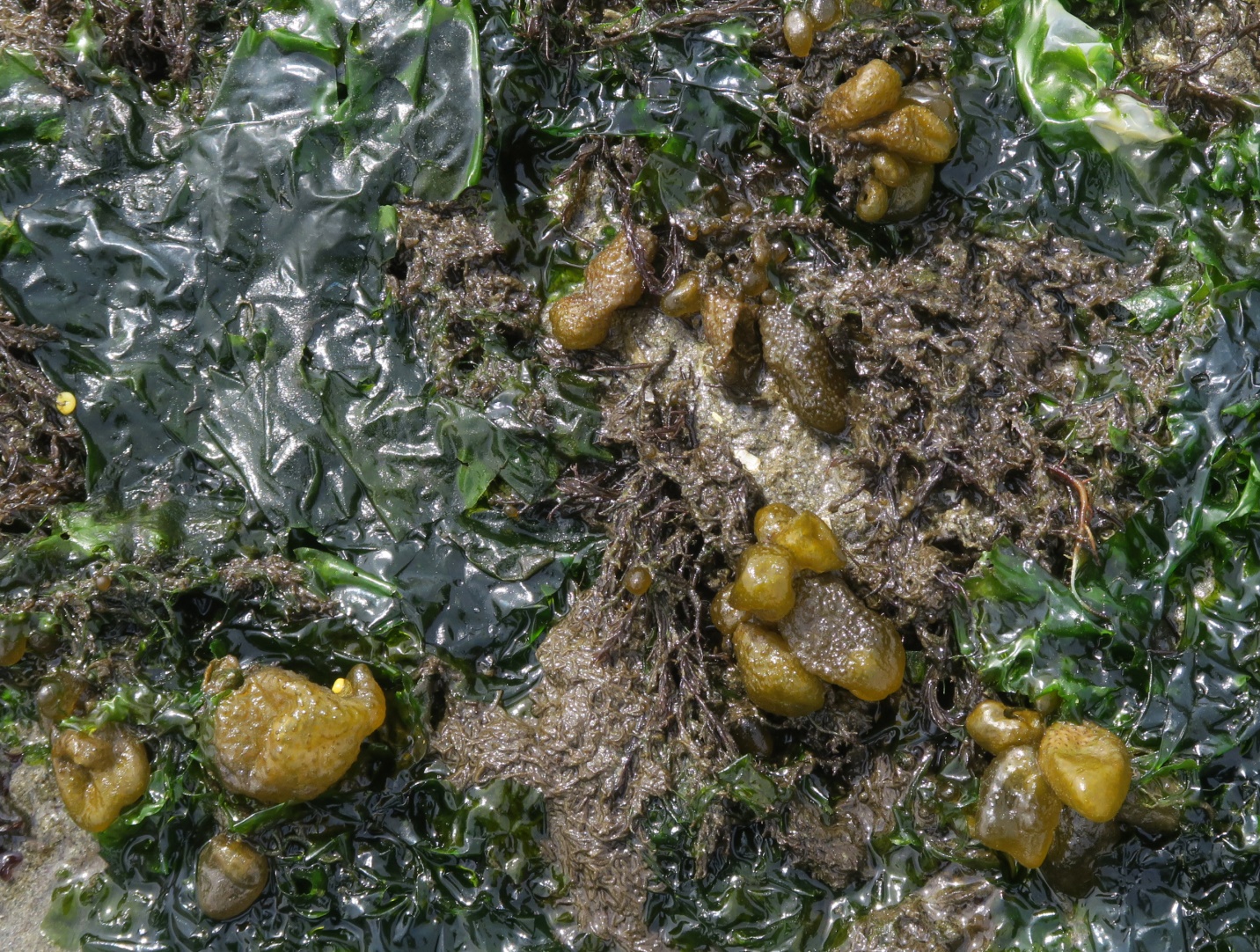
Soranthera ulvoidea
Studded Sea Balloons
13 June 2021
Bazan Bay, Haro Strait, B.C., Canada.
Tide: 0.7 foot tide 13:02 pm PDT (measured at Sidney Tidal Station)
Conditions: Mainly overcast (90% cloud cover), no precipitation, wind calm, sea smooth, 18˚C. Phase of Moon: Waxing Crescent (approx. 80 hours into this phase at time of interaction); (Previous Phase, New Moon, 10 June 2021 at 3:52am PDT: Next Phase, First Quarter, 17 June 2021 at 8:54pm PDT.)

Figure 1: This grouping of “floating” Studded Sea Balloons is living in a large tide pool. The individual balloons are affixed epiphytically to an Odonthalia species of red alga. Gonzales Bay, Juan de Fuca Strait, B.C., Canada. June 28, 2022. Photo ID 27525 ©Seaweedwhisperings.com
Person 1:
Looks somewhat liked jellied candies.
Amorphous blob.
Not ugly, not pretty.
Studs look most like flattened nipples, very round and dark/purple brown against an olive/green background.
Epiphytic on finely branched red seaweed.
Pulls off very easily from host – wonder if they dislodge in even a small storm. Perhaps they need sheltered waters such as here at Bazan Bay.
Holdfast is loosely branched, doesn’t look strong.
Slightly rough to the touch.
Looks rather inert.
Don’t seem to be very common…, narrow range of tolerance?
Not exciting, not excitable.
Not worldly, not concerned about appearance.

Figure 2: A closer view shows the Sea Balloons and their ‘studded’ surfaces. In the background it is apparent that the profusely branched host red alga, Odonthalia floccosa, doesn’t look ‘red’ at all, as at this season it is completely coated in fuzzy beige colored diatoms. Gonzales Bay, Juan de Fuca Strait, B.C., Canada. June 28, 2022. Photo ID 27526 ©Seaweedwhisperings.com
Person 2:
Balloons – sort of, but very irregularly shaped and the surface is not smooth but bumpy because it is covered with small round protuberances.
You do grow in groupings, like a bunch of balloons all tied to the branch of Odonthalia to anchor you in your intertidal habitat.
I touched one to look more closely; it pulled free very easily.
Float away – would you enjoy that? Yes, at first, but then you’d see you will be floating endlessly, alone, at sea with only your ‘god’ for company.
You’re curious looking, not pretty at all, almost a bit too “revealed” – warts and imperfections and all.
I don’t think matters regarding your physical self / appearance concern you much at all – no, it’s more that you have a good vehicle, a capsule or a balloon that will allow you to freely explore, explore the universe within.
I don’t find you often – happenchance?
I don’t think you persist in any one place for long – short lived also, possibly?
I noted to take more photos today, because experience has taught me I may not find you again for a year or more.
Your ‘balloons’ hold air and at the right water levels you float higher than your host – bobbing in the water like a crab or lobster trap float.
Only these “floats” are not marking treasure to haul up – they’re practicing / preparing for their take off – to float away!!
Float away endlessly. Happy in its own universe.
Where next might you appear, Soranthera?

Figure 3: Closer view, Soranthera ulvoidea; the genus name is given for the ‘sori’ – the drawer studs which are reproductive spore producing structures. The balloons themselves are hollow and dimpled and not at all regular in shape. Bazan Bay, Haro Strait, B.C, Canada. June 13, 2021. Photo ID 27527 ©Seaweedwhisperings.com
Biology & Natural History Information:
Description:
Thallus is pale to olive brown, globose, dimpled and hollow, 3 to 6 cm in diameter and tapering to an inconspicuous, discoid holdfast. This saccate brown alga is dotted with evenly distributed sori (spore containing structures) that are darker brown in color and give the alga a warty appearance. Studded Sea Balloon is common to abundant and occurs strictly as an epiphyte on two genera of red algae, Neorhodomela and Odonthalia.
Habitat:
This spring and summer annual is found in the mid to low intertidal zones from protected to semi-exposed habitats.
Distribution:
Bering Sea and Aleutian Islands, Alaska, to Santa Barbara California; Commander Islands, Russia.
Remarks:
Individuals from southern British Columbia / norther Washington can withstand a week of immersion in water at 20˚C but die at higher temperatures.
This is the type species (holotype) of the genus Soranthera.
Classification:
Phylum: Ochrophyta
Class: Phaeophyceae
Order: Ectocarpales
Family: Chordariaceae
Genus: Soranthera
Species: Soranthera ulvoidea Postels & Ruprecht 1840
Other name(s): Asperococcus ulvoides (Postels & Ruprecht) Ruprecht 1850

Figure 4: A grouping of Studded Sea Balloons, resting on their anchoring alga and with some bright green Ulva at low tide. This species has a limited presence seasonally and because the spores settle and grow on new hosts annually, you can’t really plan to encounter them – only check where they may show up. Bazan Bay, Haro Strait, B.C, Canada. June 13, 2021. Photo ID 27528 ©Seaweedwhisperings.com
![]()